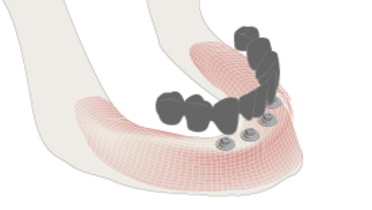-
0
Patient Assessment
- 0.1 Patient demand
- 0.2 Overarching considerations
- 0.3 Local history
- 0.4 Anatomical location
- 0.5 General patient history
-
0.6
Risk assessment & special high risk categories
- 5.1 Risk assessment & special high risk categories
- 5.2 age
- 5.3 Compliance
- 5.4 Smoking
- 5.5 Drug abuse
- 5.6 Recreational drugs and alcohol abuse
- 5.7 Parafunctions
- 5.8 Diabetes
- 5.9 Osteoporosis
- 5.10 Coagulation disorders and anticoagulant therapy
- 5.11 Steroids
- 5.12 Bisphosphonates
- 5.13 BRONJ / ARONJ
- 5.14 Radiotherapy
- 5.15 Risk factors
-
1
Diagnostics
-
1.1
Clinical Assessment
- 0.1 Lip line
- 0.2 Mouth opening
- 0.3 Vertical dimension
- 0.4 Maxillo-mandibular relationship
- 0.5 TMD
- 0.6 Existing prosthesis
- 0.7 Muco-gingival junction
- 0.8 Hyposalivation and Xerostomia
- 1.2 Clinical findings
-
1.3
Clinical diagnostic assessments
- 2.1 Microbiology
- 2.2 Salivary output
-
1.4
Diagnostic imaging
- 3.1 Imaging overview
- 3.2 Intraoral radiographs
- 3.3 Panoramic
- 3.4 CBCT
- 3.5 CT
- 1.5 Diagnostic prosthodontic guides
-
1.1
Clinical Assessment
-
2
Treatment Options
- 2.1 Mucosally-supported
-
2.2
Implant-retained/supported, general
- 1.1 Prosthodontic options overview
- 1.2 Number of implants maxilla and mandible
- 1.3 Time to function
- 1.4 Submerged or non-submerged
- 1.5 Soft tissue management
- 1.6 Hard tissue management, mandible
- 1.7 Hard tissue management, maxilla
- 1.8 Need for grafting
- 1.9 Healed vs fresh extraction socket
- 1.10 Digital treatment planning protocols
- 2.3 Implant prosthetics - removable
-
2.4
Implant prosthetics - fixed
- 2.5 Comprehensive treatment concepts
-
3
Treatment Procedures
-
3.1
Surgical
-
3.2
Removable prosthetics
-
3.3
Fixed prosthetics
-
3.1
Surgical
- 4 Aftercare
Framework trial placement
Key points
- It is important to check framework fit prior to processing the fixed complete denture
- An additional trial placement with the framework is recommended prior to completing fabrication of the definitive prosthesis
Evaluation of Framework
At this appointment, the prosthesis framework is evaluated for accuracy of fit, appropriate contour to faciltate oral hygiene access and the necessary balance of structural morphology for rigidity/strength and sufficient space to accommodate veneering materials.
Accuracy of fit
A framework needs to fit extremely well against implants or abutments to ensure passive seating and optimal cross-arch stress distribution during functional and parafunctional loading. When abutments are used, direct visual inspection of the framework against the abutments may be possible. In instances where the framework attaches directly to implants or to abutments with shoulders placed sub-mucosally, radiographic verification is indicated although this form of imaging is likely less sensitive than direct visualization.
Passivity of a framework can be tested using the one screw test which is akin to the Sheffield test. The Glossary of Oral and Maxillofacial Implants defines the one screw test as follows:
Test to determine passive fit when trying in or delivering a multiple-unit implant-supported prosthesis. By inserting a screw in one end of the prosthesis and then observing whether the prosthesis lifts off of other implant or abutment platforms, the clinician can determine the presence or absence of movement when that single screw is tightened, either by clinical or radiographic visualization of the prosthesis relative to the implant-abutment position. Ideally, there should be no movement or lift-off of the prosthesis from its passive seating.
Appropriate contour to facilitate oral hygiene access
The underside of a framework that touches mucosal surfaces should be highly polished to counteract plaque retention. In addition, surfaces should be contoured to provide a concave surface for plaque removal using dental floss. Following on, within any limitations imposed by esthetic demands, providing access for toothbrushes and other oral hygiene aids in order to facilitate plaque removal is recommended.
Strength/rigidity and space for veneering materials
The use of specific cross-sectional designs can significantly add to the rigidity and strength of frameworks. Different alloys have different mechanical properties. In general, to minimize cost, reduce prosthesis bulk and weight, and to provide sufficient space for veneering materials, a good general rule is to fabricate the smallest framework that will satisfy all of these requirements. In situations where interach distance is limited, use of a direct to implant connection for the prosthesis may be indicated so that the necessary framework bulk can achieved.
Acrylic teeth prosthesis: Wax trial placement
The final wax trial placement with the denture teeth transferred to the framework could also be carried out at this appointment to reconfirm esthetics, occlusion and vertical dimension. Once the patient has approved the tooth arrangment and the clinician has verified the necessary fit and contour of the framework, the wax trial prosthesis which includes the framework is sent to the laboratory for processing.
Metal Ceramic or ceramic prosthesis: Bisque bake trial placement
Before definitive glazing and staining of ceramic, metal ceramic or all-ceramic prosthesis can trial placed with veneering porcelain in the bisque bake phase. Recontouring can then be accomplished or porcelain added as necessary before final glazing and staining takes place.


